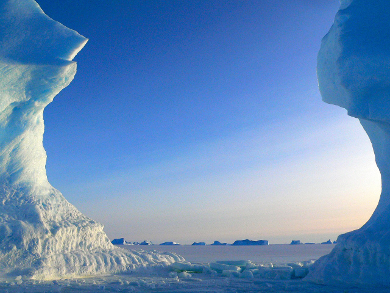Antarctica is surrounded by huge ice shelves which prevent the outflow of ice from the land to the sea. Johannes Fürst, University of Erlangen-Nuremberg, Germany, and colleagues used radar data from satellites such as European Space Agency (ESA)’s European remote sensing satellite (ERS) and Envisat, together with observations of ice thickness from airborne surveys, in a complex model to demonstrate how the buttressing role of the ice shelves is being compromised as the shelves get thinner and retreat inland.
They found that there is a critical point where these shelves act as a safety band, holding back the ice that flows towards the sea. They label frontal areas as ‘passive shelf ice’, which can be removed without major dynamic implications. If more of an ice shelf is lost, the flow of glaciers behind can speed up. This could be the point of no return and contribute to sea-level rise.
The ice shelves in the Amundsen and Bellingshausen seas have limited or almost no ‘passive’ portion, which implies that further retreat of current ice-shelf fronts will yield important dynamic consequences. This region is particularly vulnerable as ice shelves have been thinning at high rates for two decades and as upstream ice rests on a sloping bed, a precondition to marine ice-sheet instability.
Larsen C Ice Shelf in the Weddell Sea, in contrast, exhibits a large ‘passive’ frontal area. This suggests that the imminent detachment of a vast tabular iceberg (i.e., with steep sides and a flat top) is unlikely to instantly produce much dynamic change. According to the researchers, this discovery will help improve the prediction of future ice outflow from Antarctica.
- The safety band of Antarctic ice shelves,
Johannes Jakob Fürst, Gaël Durand, Fabien Gillet-Chaulet, Laure Tavard, Melanie Rankl, Matthias Braun, Olivier Gagliardini,
Nature Clim. Change 2016.
DOI: 10.1038/nclimate2912




